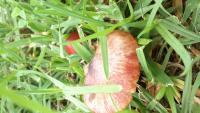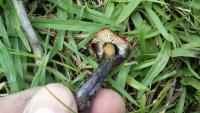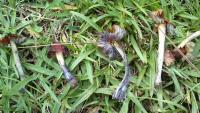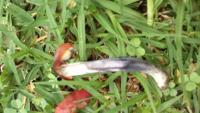gnome82 Posted April 12, 2014 Scratching head not sure about these... Found these on two distant westrnsyd lawns same day Would appreciate an I'd purely for curiosity, as they were fed to the lawn mower Share this post Link to post Share on other sites
0 Berengar Posted April 12, 2014 It is a Hygrocybe species. The closes we have in the northern hemisphere is Hygrocybe conica, but species in that group have yellow stipes. I've seen this species before, but have no idea what to call it, I hope someone from Australia comes up with a name! 1 Share this post Link to post Share on other sites
0 paradox Posted April 13, 2014 the light is a bit washed out in those pics but by the looks the stipe on those is yellow, i'd say they are H. conica Share this post Link to post Share on other sites
0 Berengar Posted April 13, 2014 That species does not grow in Australia. I'm sure they have a different name for it down there. But I've seen pictures of this species before, it's definitely closely related to H. conica, but it has some distinctive features. Share this post Link to post Share on other sites
0 paradox Posted April 13, 2014 H. conica does grow in australia, mostly is an urban species though so almost certainly not native, though i guess it could be H. astatogala Share this post Link to post Share on other sites
0 Berengar Posted April 13, 2014 (edited) That's what I meant, it does grow there, but they have recently found tiny genetic distinctions between collections on different continents, and are now giving them different names. I guess taxonomists got to have something to do... However, OP's mushroom is a distinct species, one I've tried to find a name for for quite a while. Edited April 13, 2014 by Tangich Share this post Link to post Share on other sites
Scratching head not sure about these...
Found these on two distant westrnsyd lawns same day
Would appreciate an I'd purely for curiosity, as they were fed to the lawn mower




Share this post
Link to post
Share on other sites